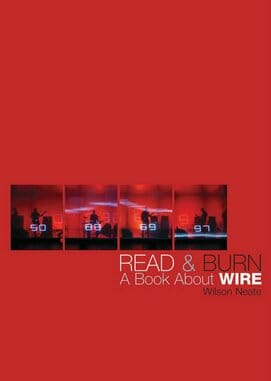Read & Burn: A Book About Wire by Wilson Neate
Man on Wire

Read & Burn: A Book About Wire starts with a list:
This book was not read, vetted, or approved by Wire…
This book is not a biography of Wire…
This book is about the band-members’ solo project
This book does not forensically dissect each of Wire’s albums This book does not mention every Wire song…
This book does not provide a complete discography…
This book does not compile or comprehensively analyze press coverage
It’s an odd way of kicking things off, and it may leave the reader wondering—what didn’t author Wilson Neate rule out? Perhaps the book contains a series of haikus based on Wire song titles? Or maybe a two-man play using Wire’s lyrics as dialogue—one actor does his laundry, repeating the phrase, “I’ve got you in a corner,” while the other actor softly mumbles “Next week will fix your problems” (both lines from Wire’s debut album).
But Read & Burn contains no haiku, no playwriting. Neate—who also crafted the 33 1/3 series’ entry on Wire’s first album—combines most of the things that he says his book is not…into what it is, a detailed and straightforward examination of the men in the band Wire and the music they made. There’s some biography, some forensics, a lot of songs, plenty of discography, interviews and a generous helping of press coverage.
English art school boys Colin Newman, Bruce Gilbert, Robert Grey and Graham Lewis released their debut full-length as Wire in 1977, not long after punk exploded in England with the Sex Pistols and The Clash. The group’s first three albums attracted many admirers, on both sides of the Atlantic: Big Black, REM, Throbbing Gristle, My Bloody Valentine, Minutemen (whose Mike Watt wrote this book’s foreword) and Elastica have all covered Wire songs or vocalized appreciation for the band.
The critic Sasha Frere-Jones even went so far as to write that, “[i]f art-pop is a thing (probable) and the Beatles invented it (pretty sure), then Wire did it better. . . than anybody,” which is of course a ludicrously provocative statement. But the band has many dedicated fans—probably the target audience for Neate’s opening barrage of disavowals.
According to Wire’s own Newman, the band’s debut album attempted “to give punk rock a good kicking.” Or as Lewis notes, the record operated “against what exists.” What Wire set out to be against included the bluesy, R&B base of rock, as well as its “cheerfulness and looseness.” Also, the group wanted to demonstrate that punk had (already in 1977) stagnated and solidified into a restrictive orthodoxy, instead of functioning as a force that spurred innovation and experimentation.
Although Neate points out (again and again and again) that Wire still used punk’s language at this point in its career, Pink Flag worked to cut away any extraneous elements from music. “No solos; no decoration; when the words run out, it stops; we don’t chorus out; no rocking out; keep it to the point; no Americanisms.” The album’s a streamlined series of short, sharp, guitar-driven tracks, full of points, dots, dashes and fuzz.
The band made its next two albums different. For the second, Chairs Missing, “‘[t]here was a definite shift of emphasis to slightly stranger areas. . . using effects rather than thrashing away’” and using the studio itself to warp and manipulate instruments, leaving behind the bare-bones rock lineup and uncaging its sound. “Keyboards were used to create atmosphere” and “to get beyond the limitations of guitars.” Songs came “slower and more developed.”
-

-

-

-

-

-

-

-

-

-

-

-

-

-

-

-

-

-

-

-

-

-

-

-

-

-

-

-

-

-

-

-

-

-

-

-

-

-

-

-








































